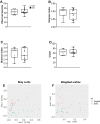Developmental vitamin D-deficiency produces autism-relevant behaviours and gut-health associated alterations in a rat model
- PMID: 37316481
- PMCID: PMC10267107
- DOI: 10.1038/s41398-023-02513-3
Developmental vitamin D-deficiency produces autism-relevant behaviours and gut-health associated alterations in a rat model
Abstract
Developmental vitamin D (DVD)-deficiency is an epidemiologically established risk factor for autism. Emerging studies also highlight the involvement of gut microbiome/gut physiology in autism. The current study aims to examine the effect of DVD-deficiency on a broad range of autism-relevant behavioural phenotypes and gut health. Vitamin D deficient rat dams exhibited altered maternal care, DVD-deficient pups showed increased ultrasonic vocalizations and as adolescents, social behaviour impairments and increased repetitive self-grooming behaviour. There were significant impacts of DVD-deficiency on gut health demonstrated by alterations to the microbiome, decreased villi length and increased ileal propionate levels. Overall, our animal model of this epidemiologically validated risk exposure for autism shows an expanded range of autism-related behavioural phenotypes and now alterations in gut microbiome that correlate with social behavioural deficits raising the possibility that DVD-deficiency induced ASD-like behaviours are due to alterations in gut health.
© 2023. Crown.
Conflict of interest statement
The authors declare no competing interests.
Figures






References
Publication types
MeSH terms
LinkOut - more resources
Full Text Sources
Medical

